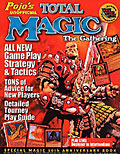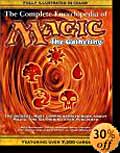As I mentioned in
my first article, I have been playing Magic almost
since it came out. I started in the Spring of 1994.
At the time, Magic was a phenomenon unlike any that
gaming had ever seen. The concept, the mechanics,
everything about it was so fresh, yet felt so
familiar, it was really a remarkable game. One of
the amazing things about Magic is its ability to
change. Other games since have tried to duplicate
it, but Magic stands alone as a game able to shift
without tremendously changing the game itself. Other
CCGs only wish they could have no major rules
revisions in six years (has it been THAT long since
6th Edition came out?!), and still be able to feel
so fresh and interesting. For example, look at card
types. I've played games that added some new card
type every expansion. Magic didn't see a new card
type for a whopping nine years, ending the drought
when Equipment was introduced in Mirrodin.
Magic's strength lies in it's ability to be molded
and have certain aspects be more important than
others, dependent on the card pool at any given
time. Some people don't like the constant shift that
Standard and Block Constructed play involves. For
those people, there is Legacy and Vintage formats to
fiddle with. For the rest of us, it means a lot of
fun. Back in the Summer of 1998, I went to Origins,
which is a great gaming convention to go check out
should you have the chance. Back then, Magic US
Nationals was held at Origins. The day before
Nationals started, they held the "meat grinders", a
series of single elimination tournaments to give
people a last shot at qualifying for Nationals.
David Williams had shown me the deck he used in the
first grinder, a deck that used Living Death and a
new card from Exodus, Survival of the Fittest. I
really liked the deck and was showing it to fellow
Guildmage (and Pojo writer) Jeff Zandi. To this day,
I remember him saying, "I don't know, I don't really
like any deck that relies on a five casting cost
Sorcery to win the game." Fast forward to modern
times, when the arguably best deck in Standard
relies on what is functionally a sorcery that costs
nine to cast! A nine casting cost sorcery that is
often used to search up a five casting cost goblin
and an eight casting cost artifact creature, to
boot! Block constructed stars creatures that cost as
much as ten mana to play. It's pretty awesome how
Magic is able to change and adapt and stay
interesting for so long.
In light of this, I thought I would take a look at
some reprinted cards from the newly-released Ninth
Edition set. Some of these cards are better than
they used to be, some are not so much so.
Blinking Spirit -- This is an oldie but a goodie.
Back in the old days, this was a card used primarily
as a stalling creature in Blue/White control decks.
In a format with cards like Balance and Icy
Manipulator and several undercosted counterspells,
this card could easily go the distance on its own.
Nowadays, the undercosted counterspells are not the
factor they once were, but the existence of Kamigawa
block adds a completely new dimension to this
creature. Many cards in Kamigawa block have
abilities that trigger from a spirit coming into
play that could be good with this card. A couple
standouts include Haru-Onna, Oyobi, Who Split the
Heavens, and Sire of the Storm. The four casting
cost is a steep price by today's standards for a 2/2
creature, but the ability to repeat spiritcraft
triggers that do not require commiting multiple
creatures to the board just might be enough to get
this creature back into standard play.
Fellwar Stone -- This card was very playable from
when it first came out, but eventually became less
used as tournament magic sped up through sets like
Tempest and Urza's Saga. Today, this kind of good
mana acceleration and flexibility is likely to find
a home in several Standard decks. The Mirrodin
Talismans are played just for their acceleration
capabilities in colors like Blue and White which
usually do not get acceleration, and Fellwar Stone
is a strong candidate to take their places. Thanks
to the Pain Lands coming back in 9th, the mana
fixing of Talismans isn't as important, so being
able to have access to fast mana without pain could
possibly get this back on the scene.
Horror of Horrors -- This card was not used in the
old days as much because of the terrible wording, as
it was simply because it stunk. The wording has
gotten streamlined, but this effect is just not
enough to make it into constructed play. In a black
deck, you're usually not wanting your creatures to
get into fights where regeneration would be a
helpful addition.
Jade Statue -- Here's a card definitely seeing the
effects of time. Many years ago, this was playable
in large part because of the prevalence of control
decks that liked to use Wrath of God and Balance to
clean the board. Wrath of God is still around, but
Balance is obviously long gone, and this card's
playability is questionable, at best. It's not
particularly efficient, being artifact in an
environment with more artifact destruction than
basic lands in some decks, and the decks are simply
not built to incorporate this style of card. Why
attack on turn four with a 3/6 when you can wait a
turn and be sending in an 11/11 trampler or be going
crazy with Kiki-Jiki and Sundering Titan? It's a
nice blast from the past, but not likely to be
winning any games soon.
Paladin En-vec -- Paladin En-vec is a card that
White Weenie strategies absolutely love. It is
reasonably costed and has a pile of free abilities
on it. In the old days it was a must, and I don't
see that changing a whole lot. The only problem with
this creature is how it fits on the mana curve in a
deck that loves to play two drops. However this
could be to its benefit in fighting off a card like
Celestial Kirin.
Shard Phoenix -- Now this is fascinating. This card
was a potent part of an old strategy that used
Forbid to lock up the game. Today, there's no
Forbid, but this card could still see play. I'm not
sure about right now, as Tooth and Nail doesn't even
care about this card, but after Mirrodin rotates
out, Shard Phoenix's ability to do two damage to all
creatures could be more of a factor. However, I can
see this being an important component in a Black/Red
control deck of sorts. Imagine using this and Exile
into Darkness in a deck with Mindslicer, for
example.
Ninth Edition is a very cool set with a lot of fun
new cards. Have fun exploring the past, and
hopefully some "old-timers" will be able to take
this chance to shine again!
Tim Stoltzfus
morefuncomics@gmail.com



